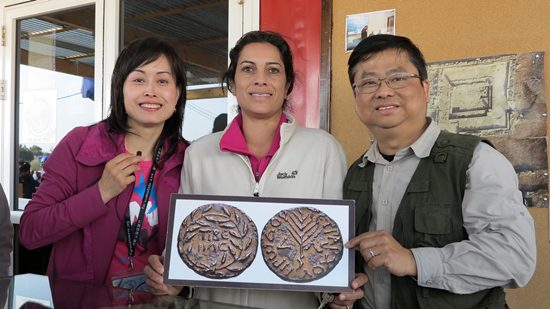Archaeologists had always believed that there are only 3 synagogues which belong to the First Century in Israel. They are Herodion, Masada and Gamla. Gamla was built in the Second Temple era, because one synagogue was needed at that time. Herodion and Masada were built during the period of the first Jewish revolt to struggle against the Roman rule (year 66-73), both of them were rebuilt from the buildings of King Herod.
In 2009, Israel Antiquities Authority found the fourth synagogue - Magdala - when they did archaeological activities at Magdala Beach on the shore of the Sea of Galilee. The synagogue was put to use in the Second Temple era (year 50 B.C.-100 A.D.) It is one of the 6 synagogues that were found in the Second Temple era and one of the oldest synagogues in Israel.


The study tour was led by Pastor Francis Choi and his wife, Nadia Choi. This Holy Land study tour consists of 76 people from Seattle, Beijing, Singapore, Canada and Hong Kong. They submitted application several months ago and received special approval towards the end to enter this historical site on Dec. 28, 2013. Till now, this historical site has not been visited publicly by normal tour group. The appropriate authority confirmed again and again that this was the first time for Chinese study tour to visit this old synagogue.
Magdala means "tower". Magdala was a fishing port in ancient time. It used to be a primary administration center on the east of Galilee. However, after Herod Antipas set Tiberias as the capital of Galilee, the importance of Magdala as an administration center began to decline day by day, but it was still an important city. Magdala was ceded to Herod Agrippa, who is the great-grandson of Herod the Great. The Jewish classics indicates that Magdala was on a very important position during the period of the first Jewish revolt (year 66-73) and the time of the Second Temple was destroyed (year 70). When Galilee and Tiberias have surrendered, Magdala still struggled against Roman very hard. A naval battle between Jews and Romans happened at Magdala in year 66, and Jews was completely annihilated. However, the archaeologist found a well-preserved "Jesus Boat" according to this naval battle. Bible mentions that is a community where Mary Magdalene lives in. Refer to Matthew chapter 27, section 56, "Among whom was Mary Magdalene, and Mary, the mother of James and Joseph, and the mother of the sons of Zebedee." Apart from this, Bible does not mention Magdala.
The main hall of Magdala synagogue is about 120 square meters (about 1300 square feet). Beside the wall, there's stone bench for congregation to sit. There are delicate decoration and colorful mural on the wall, and part of the floor was covered with a mosaic. In the middle of the synagogue, there's a square stone which is engraved with anaglyph on the upside and four sides. And one side is engraved with a seven-light stand which is on a triangular base, each side of it are engraved with an amphora and a stone pillar separately. This seven-light stand which belongs to the Second Temple era/early Roman period is the first stone carving anaglyph that has been found. In addition, a mosaic drawing with a fishing boat is also found in Magdala synagogue.
Until the mid of 2013, visitors are still not allowed to enter the magdala synagogue. The street outside the synagogue is kept well, and you could find some clean water pools that supplied by water conveyance system. The foundation of the construction is built by basalt, which is a commonly used dark volcanic rock in the Golan Heights. According to the currencies and potteries founded from the remains, the archaeologists deduced that the magdala synagogue was built in the first century. In addition to mentioned Magdala related to Mary Magdalene in the Bible, the early Roman city also have a great reference value for understanding a variety of livings in Galilee.














